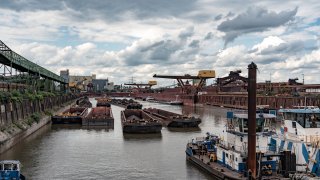
- Last week the river Rhine at Kaub, a town about 50 miles west of Frankfurt where water levels are closely followed, fell to its lowest this year.
- The cost of transporting a metric ton of diesel on the Rhine to Karlsruhe in southwest Germany doubled to around 50 euros ($55) between mid-May and mid-July, according to Deutsche Bank.
- Redesigned vessels and predictive software are some of the ways the supply chain is attempting to tackle the problem.
The drought in Europe is not only causing wildfires and risks to food security but is also threatening the shipments carried on the continent's rivers, due to falling water levels.
The river Rhine, an important trade route that runs through Germany via European cities to the port of Rotterdam, has become shallower at critical points. Last week, the water at Kaub, a town about 50 miles west of Frankfurt where levels are closely followed, fell to its lowest this year.
As water levels go down, a vessel's capacity reduces and shipping costs rise, with prices increasing as rivers become shallower. Last month, shipping companies such as Maersk and Hapag-Lloyd said low water in the Rhine meant surcharges would be passed on to customers.
Get DFW local news, weather forecasts and entertainment stories to your inbox. Sign up for NBC DFW newsletters.
"The shipping volumes on the river Rhine have been more or less consistent for the past 20 years or so," said Tim Beckhoff, a procurement and supplier management expert at McKinsey. "And, since 2021, we've seen them now dropping year over year. It's a trend, and probably a trend that's going to continue," he told CNBC via telephone.
Goods like oil, chemicals and grains are shipped on the Rhine and water levels fell so low that some vessels sailed only a quarter full in August last year. In 2018, freight transported on Germany's inland waterways was down 11.1% year-over-year, according to Deutsche Bank.
Economic impact
Money Report
Switching to other modes of transport is an option, but it is expensive. A large Rhine barge of about 135m long with a draft of 3m (the maximum depth of the vessel) can carry around 2,700 tons of freight, according to Marc Schattenberg, a Deutsche Bank economist. It would take about 110 large trucks to transport the same load via road, per his calculations.
"These figures illustrate the magnitude that limit rerouting, since alternative means of transport are also running at high capacity," he told CNBC by email.
The cost of transporting a metric ton of diesel on the Rhine to Karlsruhe in southwest Germany doubled to around 50 euros ($55) between May and mid-July, Schattenberg added. "Significant quantities of heating oil and diesel are transported via the Rhine. In the regions which are supplied in this way, this exerts significant price pressure on these products," he said.
The ripple effect of shallow rivers can be substantial. "Whole economies depend on this relatively low cost mode of transportation," Beckhoff told CNBC.

Falling water levels can "significantly impair" manufacturing output, according to the Kiel Institute for the World Economy (IFW). The water at Kaub fell so low for 30 days in 2018 that water transportation on the Rhine reduced by about 25% and industrial output in Germany fell by 1%, the IFW said in a 2020 report.
Schattenberg said the transportation industry is likely to be shaken up in a number of ways because of the long-term effects of low water, such as adaptations to ships that let them pass through shallower rivers.
New technology
In May, chemicals company BASF launched a vessel with Stolt Tankers, making the decision to do so after the extended period of low water in 2018. BASF, which operates what it claims is the world's largest chemicals plant at Ludwigshafen on the bank of the Rhine, said the ship will have double the loading capacity of a conventional vessel when the water at Kaub is moderately low.
"Companies are likely to adjust their supply chains and warehousing during periods when logistics problems related to low water are expected. Investments in the expansion of predictive software could be conceivable," Schattenberg added.
Beckhoff at McKinsey said a number of clients are using predictive software to help them move from a supply chain that prioritizes cost and quality to one that focuses on being resilient and agile. But these investments take a while to pay off. "The ones who are really successful are the ones who started looking to this four or five, six years ago," Beckhoff said.
Alongside adaptations to ships and investments in tech, some other solutions are being proposed.
"There is also discussion about expanding/dredging shipping channels. However, this is expensive and can have harmful negative effects on the environment," Schattenberg said.






